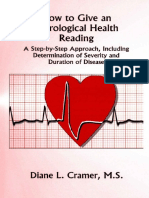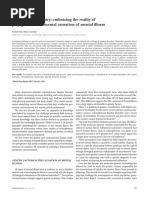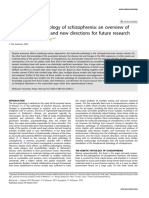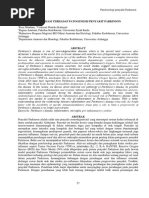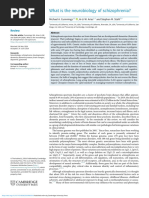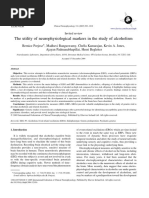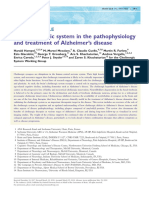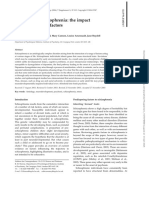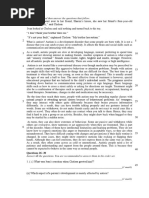nihms82893
nihms82893
Uploaded by
fracalCopyright:
Available Formats
nihms82893
nihms82893
Uploaded by
fracalCopyright
Available Formats
Share this document
Did you find this document useful?
Is this content inappropriate?
Copyright:
Available Formats
nihms82893
nihms82893
Uploaded by
fracalCopyright:
Available Formats
NIH Public Access
Author Manuscript
Neuromolecular Med. Author manuscript; available in PMC 2010 February 1.
Published in final edited form as:
NIH-PA Author Manuscript
Neuromolecular Med. 2008 ; 10(1): 1. doi:10.1007/s12017-007-8016-8.
Neurodegenerative Diseases: Neurotoxins as Sufficient Etiologic
Agents?
Christopher A. Shaw and
Department of Ophthalmology, University of British Columbia, Vancouver, BC, Canada
Department of Experimental Medicine and the Neuroscience Program, University of British
Columbia, Vancouver, BC, Canada
Günter U. Höglinger
Experimental Neurology, Philipps University, 35033 Marburg, Germany
Abstract
NIH-PA Author Manuscript
A dominant paradigm in neurological disease research is that the primary etiological factors for
diseases such as Alzheimer’s (AD), Parkinson’s (PD), and amyotrophic lateral sclerosis (ALS) are
genetic. Opposed to this perspective are the clear observations from epidemiology that purely genetic
casual factors account for a relatively small fraction of all cases. Many who support a genetic etiology
for neurological disease take the view that while the percentages may be relatively small, these
numbers will rise in the future with the inevitable discoveries of additional genetic mutations. The
follow up argument is that even if the last is not true, the events triggered by the aberrant genes
identified so far will be shown to impact the same neuronal cell death pathways as those activated
by environmental factors that trigger most sporadic disease cases. In this article we present a
countervailing view that environmental neurotoxins may be the sole sufficient factor in at least three
neurological disease clusters. For each, neurotoxins have been isolated and characterized that, at least
in animal models, faithfully reproduce each disorder without the need for genetic co-factors. Based
on these data, we will propose a set of principles that would enable any potential toxin to be evaluated
as an etiological factor in a given neurodegenerative disease. Finally, we will attempt to put
environmental toxins into the context of possible genetically-determined susceptibility.
Keywords
NIH-PA Author Manuscript
Neurological disease cluster; Atypical parkinsonism; Parkinsonism-dementia complex; ALS;
Progressive subranuclear palsy; Guam; Guadeloupe; Cycad; Annonacin; Sterol glucosides ; MPTP;
Environmental toxins
Introduction
The notion that numerous human diseases arise primarily due to genetic abnormalities is widely
accepted. The technical success of the human genome project has served to strengthen this
view, albeit without providing much insight into post-sequencing mechanisms of action. In
turn, this notion is widely touted in the media, leading to a general perception by the lay public
that a widespread genetic basis for human disease causality is an established fact. The general
© Humana Press Inc. 2007
C. A. Shaw Neural Dynamics Research Group, 828 W. 10th Ave, V5Z 1L8, Vancouver, BC, Canada, e-mail: cashawlab@gmail.com.
Christopher A. Shaw and Günter U. Höglinger are the co-primary authors of this article.
Shaw and Höglinger Page 2
perspective on neurological diseases tends to be similar. In part, this view is bolstered by
neurological disorders such as Huntington’s disease that are clearly of genetic origin. The
successful identification of mutations associated with familial forms of Alzheimer’s disease
NIH-PA Author Manuscript
(AD), Parkinson’s disease (PD), and amyotrophic lateral sclerosis (ALS) similarly supports
the notion of genetic etiology. Whatever individual scientists may say privately, it is the
‘‘gene’’ perspective that sends the vast bulk of extramural research funding—both public and
private—into studies devoted to genetic rather than toxin etiologies.
In spite of this, epidemiology tells a somewhat different story in regard to sporadic cases of
the age-dependent neurodegenerative disorders. Although estimates vary, in no case do the
known gene mutations account for more than 10% for any of these diseases overall We cannot,
however, rule out future discoveries that could serve to bring larger fractions of the sporadic
forms of each disease into the genetic causality fold. Similarly, it is undeniable that the cell
death cascades evoked by any form of genetic abnormality (i.e. gene mutations, deletions or
duplications) could be identical to those triggered in other ways, for example by neurotoxins.
In the following review, we will summarize the evidence for a neurotoxin etiology in three
well-established clusters of neurological disease and demonstrate that for each an animal model
using the putative neurotoxin can faithfully reproduce the disease state. These outcomes argue
in favor of such toxins being the sole necessary and sufficient condition for at least these disease
clusters.
NIH-PA Author Manuscript
The clusters we will consider are the following: (1) The type of parkinsonism associated with
the accidental use of MPTP by recreational drug users; (2) atypical parkinsonism of
Guadeloupe in the French Antilles; (3) The separate and combined phenotypes of ALS and
parkinsonism dementia of the Western Pacific, with a focus on the most studied of these among
the Chamorro population of Guam. From these examples, we will try to derive basic principles
to serve in the hunt for environmental toxins associated with other forms of sporadic
neurodegenerative disease. Last, we will consider the combined effects of modifier genes and
environmental toxins.
Environmental Determinants of Neurological Disease: Three Clusters
MPTP-Induced Parkinsonism
In 1983, Langston et al. reported the occurrence of an akinetic rigid syndrome responsive to
Levodopa resembling the clinical features of PD in seven individuals after intravenous injection
of an illicit synthetic heroin analog that contained high amounts of the by-product 1-methyl 4
—phenyl 1,2,3, 6-tetradhydropyridine (MPTP) (Langston et al. 1983; Ballard et al. 1985).
Subsequent studies demonstrated that systemic injection of MPTP into non-human primates
NIH-PA Author Manuscript
(Langston et al. 1984a) and mice (Ricaurte et al. 1987) induced an irreversible, selective loss
of dopaminergic neurons in the substantia nigra (SN), thus reproducing the main
neuropathological hallmark of PD. MPTP is a highly lipophilic molecule (Riachi et al. 1989)
and crosses the blood–brain-barrier in a matter of seconds after systemic administration
(Markey et al. 1984). Within the brain, MPTP is rapidly converted to the hydrophilic metabolite
1-methyl-4-phenylpyridinium ion (MPP+) (Heikkila et al. 1984; Langston et al. 1984b) which
is not lipophilic enough to cross biomembranes spontaneously (Riachi et al. 1989). The
demonstration that an inhibition of the conversion of MPTP to MPP+ by monoamine oxidase
B prevents MPTP-neurotoxicity, clearly identified MPP+ as the active toxic principle (Heikkila
et al. 1984; Langston et al. 1984b). Further work demonstrated that the cellular specificity of
MPTP for dopaminergic neurons resulted from the accumulation of MPP+ through uptake by
the dopamine transporter (Javitch et al. 1985; Ricaurte et al. 1985; Bezard et al. 1999). Within
the cell, MPP+ accumulates in the mitochondrial matrix (Ramsay and Singer 1986; Davey et
al. 1992) where it impairs respiration by inhibiting complex I (NADH-ubiquinone
Neuromolecular Med. Author manuscript; available in PMC 2010 February 1.
Shaw and Höglinger Page 3
oxidoreductase) of the electron transport chain (Nicklas et al. 1985; Singer et al. 1987). The
downstream mechanisms of MPP+–induced complex I inhibition that lead ultimately to
neuronal cell death and parkinsonism are reviewed elsewhere (Dauer and Przedborski 2003;
NIH-PA Author Manuscript
Dawson and Dawson 2003).
The relevance of MPTP-induced parkinsonism as a model for sporadic PD comes from the
demonstration of a similar impairment of mitochondrial complex I in PD (Schapira et al.
1989; Schapira et al. 1990; Mann et al. 1992; Abou-Sleiman et al. 2006; Keeney et al. 2006).
The principal differences between PD and MPTP-induced parkinsonism in the routinely used
acute and subacute intoxication protocols are the lack of chronic progression of
neurodegeneration in experimental animals and the absence of formation of typical Lewy
bodies, the protein-aceous inclusion bodies that are characteristic of PD and related disorders
(Forno et al. 1993). Recent experimental approaches utilizing chronic MPTP administration
protocols appear to demonstrate that MPTP-induced parkinsonism is even closer to ‘‘classical’’
PD in its absence of extra-nigral pathology (Fornai et al. 2005). At the same time, more detailed
studies of the timecourse of PD pathology appears to suggest that a more widespread impact
on the CNS occurs (Braak et al. 2004). MPTP may thus reflect an extremely selective form of
a disease that may have multiple manifestations.
Guadeloupean Atypical Parkinsonism
The inhabitants of Guadeloupe, a French Caribbean island, experience an unusually high
NIH-PA Author Manuscript
prevalence of atypical parkinsonism (Caparros-Lefebvre and Elbaz 1999; Caparros-Lefebvre
et al. 2006; Lannuzel et al. 2007) which exceeds that observed in European or North American
populations. Approximately one-third of the parkinsonian patients present with classical PD,
one-third with a clinical manifestation resembling progressive supranuclear palsy (PSP), and
one-third have an undetermined form of parkinsonism (Caparros-Lefebvre and Elbaz 1999;
Caparros-Lefebvre et al. 2002; Lannuzel et al. 2007). In three of the patients with PSP-like
clinical symptoms who have come to autopsy, neuropathological alterations consistent with
PSP were found (Caparros-Lefebvre et al. 2002). The absence of Mendelian inheritance or of
mutations in the MAPT or α-synuclein genes, as well as the ethnic heterogeneity of the affected
population argues against a genetic causality (Caparros-Lefebvre and Elbaz 1999; Caparros-
Lefebvre et al. 2002, 2006; Lannuzel et al. 2007). In contrast, the geographical clustering is
consistent with an environmental etiology.
A case-control study (Caparros-Lefebvre and Elbaz 1999) linked atypical parkinsonism on
Guadeloupe to the consumption of fruit and medicinal preparations of the leaves of plants of
the Annonaceae family, in particular Annona muricata (soursop, corossol) the predominant
Annonaceae on Guadeloupe. Associations between the consumption of Annonaceae and
atypical parkinsonism have also been reported in New Caledonia (Angibaud et al. 2004) and
NIH-PA Author Manuscript
in patients of Caribbean origin in living in London (Chaudhuri et al. 2000). These associations
in widely separated populations with genetically distinct backgrounds further support the
hypothesis that toxic compounds contained in Annonaceae may be responsible for the observed
neurodegenerative syndrome.
Acetogenins and alkaloids are the two major groups of candidate toxins contained in plants
from the Annonaceae family. In vitro, acetogenins are toxic to neurons at concentrations in the
nanomolar range, whereas micromolar concentrations of the alkaloids were necessary to
produce toxic outcomes (Lannuzel et al. 2002; Lannuzel et al. 2003). For this reason,
acetogenins have received greater attention in recent years. Acetogenins penetrate into cells
by passive diffusion because of their lipophilic character rather than servng as a substrate for
the dopamine transporter (Lannuzel et al. 2003). These observations explain why these
compounds are equally toxic to various dopaminergic as well as non-dopamine containing
neurons (Lannuzel et al. 2003), acting in both as potent inhibitors of mitochondrial complex I
Neuromolecular Med. Author manuscript; available in PMC 2010 February 1.
Shaw and Höglinger Page 4
(Degli Esposti 1998). Annonacin, the most abundant acetogenin in Annona muricata, inhibits
complex I activity with an IC50 of about 30 nM and kills neurons by ATP-depletion. It is about
50 times more toxic to dopaminergic neurons and 2000 times more toxic to non-dopaminergic
NIH-PA Author Manuscript
neurons than MPP+ (Lannuzel et al. 2003). When administered intravenously to rats for 28
days, annonacin enters the brain parenchyma, decreases brain ATP levels and induces
pronounced and widespread neurodegeneration in basal ganglia and brainstem nuclei;
hippocampus, cerebellum, and cerebral cortex are only moderately affected (Champy et al.
2004). These outcomes mimic the distribution of brain lesions seen in patients with atypical
parkinsonism of Guadeloupe (Caparros-Lefebvre et al. 2002). Quantification of the acetogenin
content in A. muricata fruits and products demonstrates that an adult who consumes one fruit
or can of nectar per day will ingest in 1 year the amount of annonacin relative to body weight
that induces brain lesion in rats (Champy et al. 2005). It is noteworthy that the chronic systemic
administration to rats of rotenone, another plant-derived, lipophilic, and highly potent complex
I inhibitor, produces the identical pattern of mitochondrial energy impairment and
neurodegeneration (Höglinger et al. 2003). In addition, rotenone-treated rats also develop a
cerebral tauopathy with ultrastructural and molecular features resembling those found in PSP-
brains (Höglinger et al. 2005). Annonacin is also capable of inducing somatodendritic
redistribution of abnormal tau protein in cultured neurons (Escobar-Khondiker et al. 2007).
These observations strengthen the hypothesis that natural lipophilic complex I inhibitors, such
as the acetogenins contained in annonaceous plants, are capable of inducing atypical
parkinsonism of the PSP-type. The concept that mitochondrial dysfunction plays a role in the
NIH-PA Author Manuscript
etiology of PSP-like syndromes is further supported by the observation that cybrid cells
containing mitochondria from PSP patients have defective mitochondrial function (Swerdlow
et al. 2000; Albers et al. 2001).
ALS-Parkinsonism Dementia Complex (ALS-PDC) of the Western Pacific
A high incidence of what at first appeared to be a classical form of ALS was identified by
American Navy doctors among the Chamorro people of Guam shortly after World War II
(Zimmerman 1945). Later clinical characterization (Kurland and Mulder 1954; Kurland et al.
1961) confirmed a near epidemic level of the disorder. A second disease with a similarly high
incidence was soon added to the emerging picture. This was an atypical form of parkinsonism
that presented with dementia and was named parkinsonism dementia complex (PDC) (Hirano
et al. 1961). Marked similarities to PSP have since been noted (Steele et al. 2002), both in the
abnormal expression of abnormal tau protein and in neuronal loss in regions not associated
with classical PD. The spectrum of neurological disorders of both types was collectively
referred to as ALS-PDC. Most cases were predominantly either ALS or PDC; however, there
was notable overlap with about 7% of the patients suffering from both disorders (Kurland and
Mulder 1954). A familial susceptibility to disease was noted, however affected members within
NIH-PA Author Manuscript
one family could exhibit either of the separate disorders.
Disease incidence for ALS on Guam has declined dramatically and now is only marginally
higher than the North American average. PDC appears to have declined in recent years, but
remains higher than for PD in North America (Galasko et al. 2002). Controversy still exists
concerning the extent of the decline (D. Galasko personal communication). Apparently
pathologically similar forms of ALS-PDC have been described elsewhere in the Western
Pacific, notably in Irian Jaya (western New Guinea) (Gajdusek and Salazar 1982) and the Kii
Peninsula of Honshu Island in Japan (Kurland 1972). Histologically, both Guamanian ALS
and PDC are characterized by the abundance of neurofibrillary tangles (NFT) of abnormal tau
protein whose presence in Guamanian ALS was considered to mark a significant deviation
from the classical form. However, the perception that ALS pathology does not involve
abnormal tau expression may be changing with recent descriptions of tangles found in the
temporal lobes of cognitively impaired ALS patients (Strong et al. 1999, 2006; Strong 2003).
Neuromolecular Med. Author manuscript; available in PMC 2010 February 1.
Shaw and Höglinger Page 5
In a similar manner, the presence of NFT, together with the neuronal loss outside the nigro-
striatal pathway observed in PDC, resembles both PSP and Guadeloupean atypical
parkinsonism. The dementia associated with PDC was thought by Kurland and others (Kurland
NIH-PA Author Manuscript
1972) to resemble AD in a number of aspects, albeit with an underrepresentation of amyloid-
β depositions (Winton et al. 2006), possibly making it more like frontotemporal dementia
(FTD) than AD (Galasko et al. 2002).
The increased susceptibility to ALS-PDC development in some families suggested the
influence of modifier genes, but no clear evidence of inheritance of a disease causing mutation
has since emerged (Trojanowski et al. 2002; Hermosura et al. 2005). Instead, the strongest
epidemiological data have historically supported an environmental factor(s) as causal to the
disease. The strong epidemiological link was recently reconfirmed (Borenstein et al. 2007).
Various environmental hypotheses have been put forward over the years ranging from
deficiencies in calcium and magnesium in ground water (Gajdusek and Salazar 1982) to the
presence of toxic compounds contained in the gametophyte of the local variety of cycad tree
(Cycas micronesica). Consumption of flour made from cycad seeds, termed fadang in
Chamorro, has been a recognized feature of Chamorro culture for generations (Whiting
1963), but has declined considerably since the war.
Cycad gametophytes contain various known toxins, including the amino sugar cycasin whose
NIH-PA Author Manuscript
active principle is the hepatotoxin methylazoxymethanol (MAM) as well as the free amino
acids β-oxalyoamino alanine (BOAA) and β-methylamino alanine (BMAA). MAM ingestion
in animals does not induce neural outcomes resembling ALS-PDC (Kurland et al. 1961) or
indeed show any pronounced neural impact in adult animals. BOAA, an AMPA receptor
agonist, has been linked to neurolathyrism (Spencer and Schaumburg 1983), but the features
of this disease do not closely resemble those of ALS-PDC. BMAA appears to activate both
NMDA and AMPA receptors (Weiss et al. 1989; Rao et al. 2006) in vitro, but does not generate
ALS-PDC- like features in vivo (Cruz-Aguado et al. 2006). In this regard, Spencer et al.
(1987) had originally suggested that BMAA in high doses could do so, but the behavioral
deficits and apparent pathological outcomes observed by these investigators were neither
consistent with ALS-PDC nor were they permanent once BMAA treatment ended. Later studies
failed to replicate even these minimal outcomes (Perry et al. 1989; Duncan et al. 1990; Cruz-
Aguado et al. 2006). An additional barrier to any of the above water-soluble toxins as etiologic
agents of ALS-PDC is that all elute as the seeds are washed in the traditional methods of
Chamorro cycad flour preparation (Duncan 1991; Wilson et al. 2002).
More recently, evidence for additional neurotoxins contained in cycad seeds from Guam has
emerged. In vivo feeding of washed cycad flour (lacking any of the water-soluble toxins
NIH-PA Author Manuscript
described above) to adult male mice gives rise to a progressive neurological disorder that
recreates much of the spectrum of ALS-PDC. In particular, cycad-fed mice display motor
deficits consistent with ALS and parkinsonism, including ALS-PDC olfactory and late stage
cognitive deficits (Wilson et al. 2002). Magnetic imaging and histological examination reveal
a decreased volume and neuron losses in spinal cord, SNpc, olfactory bulb, hippocampus, and
some regions of the cortex (Wilson et al. 2002, 2004, 2005). The same regions show evidence
of astrogliosis and/or microglial proliferation (Wilson et al. 2006).
Similar cycad samples fed to adult male rats generate an apparently pure parkinsonism
phenotype. At the onset of behavioral symptoms, cycad-fed rats initially unilaterally rotate,
with corresponding losses of tyrosine hydroxylase activity and neurons in SNpc and dopamine
terminals in the striatum. Both lesions are on the contralateral side to the direction of rotation
(Valentino et al. 2006). Once initiated, the disorder continues to progress in the absence of
continued exposure to cycad neurotoxins with all of the rats showing a later behavioral stage
Neuromolecular Med. Author manuscript; available in PMC 2010 February 1.
Shaw and Höglinger Page 6
characterized by freezing. This stage corresponds to the emergence of bilateral SNpc and
striatal lesions.
NIH-PA Author Manuscript
The isolation of bioactive molecules from washed cycad flour suggests that at least three sterol
glucoside variants are, individually or in combination, the active toxic principle (Khabazian et
al. 2002). Sterol glucosides of various types are known to have neurotoxic properties (Ly et
al. 2006) and due to their highly lipophilic nature may easily access the nervous system. The
largest fraction of sterol glucosides in cycad is usually β-sitosterol β-D glucoside (BSSG),
however the absolute amounts and ratios of the different sterol glucosides can vary
considerably between batches of cycad seeds. These variations likely arise due to differences
in the season harvested, locale, and, most crucially, seed age (Marler et al. 2005a): Cycad sterol
glucoside concentrations, especially in young seeds, appear to be considerably higher than for
most other plants studied to date (Marler et al. 2005b).
The identified cycad sterol glucosides are neurotoxic to primary neuronal and astroglial
cultures (Khabazian et al. 2000; Khabazian et al. 2002) as well as to an motor neuron-derived
cell line (NSC-34) (Ly et al. 2007; Ly and Shaw 2007). Studies using organotypic slices of
spinal cord, SNpc/striatum, or hippocampus with BSSG in nanomolar concentrations or a
cholesterol glucoside all show significant neuronal death over a period of days to weeks (S.
Jafri, K. Andreassen, and C. Mathews, personal communications). Synthetic BSSG fed to mice
at concentrations approximating those measured in cycad flour, gives rise to behavioral deficits
NIH-PA Author Manuscript
consistent with an ALS-like phenotype with concomitant progressive motor neuron loss in
spinal cord and later cell loss in the striatum (Wilson et al. 2006; Tabata et al. 2007). These
outcomes occur even in the absence of further exposure to BSSG.
The data from the ALS-PDC models cited above strongly supports the interpretation that
several water insoluble neurotoxic factors in cycad seeds from Guam are indeed causal to the
human disease in its various forms. Whether or not the identified sterol glucosides are alone
responsible for the all of the pathological outcomes observed in the animal experiments using
cycad seed flour is still uncertain.
A Comparison of Guadeloupean Atypical Parkinsonsim and ALS-PDC
There is considerable overlap in observed features between the parkinsonism observed in
Guadeloupean atypical parkinsonsim and ALS-PDC. For example, both can be defined as
sporadic neurodegenerative tauopathies and both show some resemblance to PSP by involving
CNS regions outside the nigro-striatal system. The differences in presentation may reflect the
strong possibility that different neurotoxins, as cited in the previous sections, are involved.
However, we cannot currently rule out the possibility that both C. micronesica and
Annonaceae may contain significant concentrations of both sterol glucosides and acetongenins.
NIH-PA Author Manuscript
We have also noted elsewhere the structural similarity of the sterol glucosides to at least one
of the toxic alkaloids, reticuline, found in Annonaceae (Slow et al. 2003).
Criteria for the Identification of Environmental Factors as Causative Agents
in Neurodegenerative Diseases
Based on the experimental approaches utilized to study ALS-PDC, Guadeloupean atypical
parkinsonism, as well as MPTP-induced parkinsonism, we propose that the following criteria
could be used to guide a search to identify and validate putative neurotoxins involved in the
etiology of sporadic neurodegenerative disease. These criteria are:
1. Epidemiological validity: Clinical and pathological evidence consistent with disease
segregation by exposure to the putative neurotoxin must exist in individuals or
particular human populations;
Neuromolecular Med. Author manuscript; available in PMC 2010 February 1.
Shaw and Höglinger Page 7
2. Agent identification: Isolation, purification, and structural determination of the
putative neurotoxin must be accomplished. The neurotoxin must be able to gain access
to the CNS under realistic conditions, e.g., ingestion or inhalation, and must, in
NIH-PA Author Manuscript
addition, exhibit plausible dosages and exposure periods;
3. Experimental modeling in vivo: Exposure of experimental animals to the neurotoxin
must recreate the human disease, both behaviorally and histopathologically;
4. Extinction by prevention: The prevention of exposure to the neurotoxic agents
should serve to eradicate the disease.
Environment-Gene Interactions and Neurodegenerative Disease
The last few years have seen an impressive increase in the knowledge of the genetic
contribution to the etiology of some neurodegenerative disorders. For example, mutations in
a single gene have been identified as being causative for Huntington’s disease. A transgenic
animal model expressing this mutation has been developed that closely mimics the disease,
thus allowing researchers to study potential neuroprotective interventions.
Most neurodegenerative disorders, however, are far more complex. In both AD and PD, for
example, only a small percentage of cases are inherited in a simple Mendelian fashion, the vast
majority remaining in the sporadic category. A similar situation exists in regard to ALS.
Nonetheless, the identification and experimental study of the genes involved in the inherited
NIH-PA Author Manuscript
forms of neurodegenerative diseases have allowed researchers to identify molecular pathways
leading to neurodegeneration and the hope remains that these will turn out to be the same as
those evoked in sporadic disease.
In AD for example, all gene defects identified so far appear to drive a common metabolic
pathway that involves the production, processing, or clearance of amyloid protein (Mayeux
2006). Such observations can guide the search for neurotoxins that affect, directly, or indirectly
the same pathway. In contrast, in PD the inherited forms of the disease do not map to a solitary
pathway. Similarly, in ALS, gene-evoked neuropathological cascades seem more likely to
involve multiple pathways. Thus for PD and ALS, the notion that identifying gene mutations
will necessarily lead to any clearer understanding of the sporadic forms of the disease is not
necessarily correct. Insofar as it is not correct, the best justification for genetic studies in these
disorders is that the events triggered may converge on common downstream targets to give
clinically and pathologically identical outcomes.
Putting Toxin-Gene Synergies into Perspective
The above discussion of the relative impact of environmental neurotoxins versus genetic factors
NIH-PA Author Manuscript
in neurological disease leads to the following conclusions: Although various gene variants/
mutations can induce a percentage of overall cases of ALS, PD, and AD, this fraction is not
large. Nor is it absolutely clear even in such cases that the aberrant genes alone are solely causal
to the disease since potential environmental factors acting in synergy cannot be discounted.
This is well illustrated by the current failure of PD transgenetic models to generate the full
pathological spectrum of the disease (Emborg 2004). The same lack of effect holds for the
animal model of the ALS2 mutation to the protein alsin (Devon et al. 2006). Gene proponents
often point to the success of the mSOD model of the various mutations involved in some
familial forms of ALS in which homozygous mice and rats develop a rapidly fatal motor neuron
loss and display many of the clinical and pathological features seen in human ALS. In this
view, these data are strong evidence for a strict genetic etiology. However, it must be noted
that high levels of expression of the mSOD mutation also impact a variety of other areas of
CNS, including the SNpc, striatum, and hippocampus, suggesting that the intensity of the insult
Neuromolecular Med. Author manuscript; available in PMC 2010 February 1.
Shaw and Höglinger Page 8
provided by the mutation is very great (Petrik et al. 2007). In contrast, low expressing mSOD
mice show relatively minor or late expressing pathological outcomes (Julien and Kriz 2006).
NIH-PA Author Manuscript
If many of the demonstrated mutations are alone insufficient to re-create the human
neurological disease in animal models, what are the chances that environmental factors alone
do so? The models discussed above—as well as various others not considered in this review
—clearly show that such potential exists. Cycad and Annona neurotoxins can be linked
epidemiologically to ALS-PDC on Guam and elsewhere, and atypical parkinsonism in various
locations, respectively. The problem here, however, is one of universality: Outside of these
rare clusters of disease, can worldwide cases of ALS, PD/parkinsonism, or AD be linked to
either group of potential toxins? The presence of various sterol glucosides from a variety of
sources suggests that these may to some extent satisfy a criterion of universality (Ly et al.
2007). The same could be true of the Annonaceous toxins, but more likely reflect not a specific
molecule but rather a number of molecules of different types that share common toxic
mechanisms of action.
Thus, although such toxins—related by type or mechanism of action—could be causal to
neurological diseases, a central question remains unanswered: Why are there not more clusters
of neurological disease? One answer may be that although such toxins can kill neurons in the
CNS at sufficient concentrations, such fatal concentrations may be rare, only occurring in
places such as Guam or Guadeloupe. Hence, the causal toxins might be ubiquitously
NIH-PA Author Manuscript
distributed, but the exposure for most people may occur at concentrations too low to induce
disease. If so, then the obvious exception might be those who share some genetic susceptibility
that influences toxin accessibility, transport, or degradation. Numerous examples of such
genetic susceptibility factors exist, one of the most widely known that of the polymorphisms
in the cholesterol transport gene apoE. In regard to the latter, cycad toxicity in mice seems to
be in part regulated by apoE variants in a manner than appears to reflect the risk of ALS and
AD in humans (Bédlâck et al. 2000; Wilson et al. 2005; Mayeux 2006).
These speculations lead to a view that is rapidly gaining support, namely that environmental
and genetic factors must interact to cause sporadic neurological diseases. This last
consideration, in addition to toxin only or gene only etiologies is illustrated in the schematic
of Fig. 1. It is also increasingly likely that toxins may directly alter gene function: Epigenetic
modifications of chromatin leading to changes in DNA methylation may be a crucial factor in
toxin-gene interactions (D’Alessio and Szyf 2006).
All of the above speculation is open to experimental scrutiny. It seems to us that an urgent
future priority in the field will be to conduct a systematic exploration of the interactions
identified neurotoxins and mutations. From such studies may come the ultimate answer and
NIH-PA Author Manuscript
hope for prophylaxis to sporadic neurodegenerative disease.
Acknowledgments
This work was supported by the US Army Medical Research and Materiel Command (#DAMD17-02-1-0678), Scottish
Rite Charitable Foundation of Canada, and the Natural Science and Engineering Research Council of Canada
(NSERC), and NINDS to CAS and European Union Grant LSHM-CT-2003-503330 to GUH. The authors thank
Michael Petrik, Dr. Reyniel Cruz-Aguado and Dr. Denis Kay for helpful suggestions and commentary.
References
Abou-Sleiman PM, Muqit MM, Wood NW. Expanding insights of mitochondrial dysfunction in
Parkinson’s disease. Natural Reviews Neuroscience 2006;7:207–219.
Neuromolecular Med. Author manuscript; available in PMC 2010 February 1.
Shaw and Höglinger Page 9
Albers DS, Swerdlow RH, Manfredi G, Gajewski C, Yang L, Parker WD Jr. Beal MF. Further evidence
for mitochondrial dysfunction in progressive supranuclear palsy. Experimental Neurology
2001;168:196–198. [PubMed: 11170735]
NIH-PA Author Manuscript
Angibaud G, Gaultier C, Rascol O. Annonaceae consumption in New Caledonia. Movement Disorders
2004;19:603–604. [PubMed: 15133832]
Ballard PA, Tetrud JW, Langston JW. Permanent human parkinsonism due to 1-methyl-4-phenyl-1,2,3,6-
tetrahydropyridine (MPTP): Seven cases. Neurology 1985;35:949–956. [PubMed: 3874373]
Bédlâck RS, Strittniatter WJ, Morgenlandèr JC. ApoIipoprotem E and neuromuscular disease: A critical
review of the literature. Archives of Neurology 2000;57:1561–1565. [PubMed: 11074787]
Bezard E, Gross CE, Fournier MC, Dovero S, Bloch B, Jaber M. Absence of MPTP-induced neuronal
death in mice lacking the dopamine transporter. Experimental Neurology 1999;155:268–273.
[PubMed: 10072302]
Borenstein AR, Mortimer JA, Schofield MPH, Wu Y, Salmon DP, Gamst A, Olichney J, Thal LJ, Sibert
L, Kaye J, Craig UL, Schellenberg GD, Galasko DR. Cycad exposure and risk of dementia, MCI, and
PDC in the Chamorro population of Guam. Neurology 2007;68:1764–1771. [PubMed: 17515538]
Braak H, Ghebremedhin E, Rub U, Bratzke H, Del Tredici K. Stages in the development of Parkinson’s
disease-related pathology. Cell and Tissue Research 2004;318:121–134. [PubMed: 15338272]
Caparros-Lefebvre D, Elbaz A. Caribbean Parkinsonism Study Group. Possible relation of atypical
parkinsonism in the French West Indies with consumption of tropical plants: A case-control study.
Lancet 1999;354:281–286. [PubMed: 10440304]
Caparros-Lefebvre D, Sergeant N, Lees A, Camuzat A, Daniel S, Lannuzel A, Brice A, Tolosa E,
NIH-PA Author Manuscript
Delacourte A, Duyckaerts C. Guadeloupean parkinsonism: A cluster of progressive supranuclear
palsy-like tauopathy. Brain 2002;125:801–811. [PubMed: 11912113]
Caparros-Lefebvre D, Steele J, Kotake Y, Ohta S. Geographic isolates of atypical Parkinsonism and
tauopathy in the tropics: Possible synergy of neurotoxins. Movement Disorders 2006;21:1769–1771.
[PubMed: 16874753]
Champy P, Höglinger GU, Feger J, Gleye C, Hocquemiller R, Laurens A, Guerineau V, Laprevote O,
Medja F, Lombes A, Michel PP, Lannuzel A, Hirsch EC, Ruberg M. Annonacin, a lipophilic inhibitor
of mitochondrial complex I, induces nigral and striatal neurodegeneration in rats: Possible relevance
for atypical parkinsonism in Guadeloupe. Journal of Neurochemistry 2004;88:63–69. [PubMed:
14675150]
Champy P, Melot C, Guerineau Eng V, Gleye C, Fall D, Höglinger GU, Ruberg C, Lannuzel A, Laprevote
O, Laurens A, Höcquemiller R. Quantification ofacetogenins in Annona muricata linked to atypical
parkinsonismin Guadeloupe. Movement Disorders 2005;20:1629–1633. [PubMed: 16078200]
Chaudhuri KR, Hu MT, Brooks DJ. Atypical parkinsonism in Afro-Caribbean and Indian origin
immigrants to the UK. Movement Disorders 2000;15:18–23. [PubMed: 10634237]
Cruz-Aguado R, Winkler D, Shaw CA. Lack of behavioral and neuropathological effects of dietary beta-
methylamino-L-alanine (BMAA) in mice. Pharmacology, Biochemistry, and Behavior 2006;84:294–
299.
D’Alessio AC, Szyf M. Epigenetic tete-a-tete: The bilateral relationship between chromatin modifications
NIH-PA Author Manuscript
and DNA methylation. Biochemistry and Cell Biology 2006;84:463–476. [PubMed: 16936820]
Dauer W, Przedborski S. Parkinson’s disease: Mechanisms and models. Neuron 2003;39:889–909.
[PubMed: 12971891]
Davey GP, Tipton KF, Murphy MP. Uptake and accumulation of 1-methyl-4-phenylpyridinium by rat
liver mitochondria measured using an ion-selective electrode. The Biochemistry Journal 1992;288
(Pt 2):439–443.
Dawson TM, Dawson VL. Molecular pathways of neurodegeneration in Parkinson’s disease. Science
2003;302:819–822. [PubMed: 14593166]
Degli Esposti M. Inhibitors of NADH-ubiquinone reductase: An overview. Biochimica Biophysica Acta
1998;1364:222–235.
Devon RS, Orban PC, Gerrow K, Barbieri MA, Schwab C, Cao LP, Helm JR, Bissada N, Cruz-Aguado
R, Davidson TL, Witmer J, Metzler M, Lam CK, Tetzlaff W, Simpson EM, McCaffery JM, El-
Hussein AE, Leavitt BR, Hayden MR. Als2-deficient mice exhibit disturbances in endosome
Neuromolecular Med. Author manuscript; available in PMC 2010 February 1.
Shaw and Höglinger Page 10
trafficking associated with motor behavioral abnormalities. Proceedings of the National Academy
of Sciences of the United States of America 2006;103:9595–9600. [PubMed: 16769894]
Duncan MW. Role of the cycad neurotoxin BMAA in the amyotrophic lateral sclerosis-parkinsonism
NIH-PA Author Manuscript
dementia complex of the western Pacific. Advances in Neurology 1991;56:301–310. [PubMed:
1853765]
Duncan MW, Steele JC, Kopin IJ, Markey SP. 2-Amino-3-(methylamino)-propanoic acid (BMAA) in
cycad flour: An unlikely cause of amyotrophic lateral sclerosis and parkinsonism-dementia of Guam.
Neurology 1990;40:767–772. [PubMed: 2330104]
Emborg ME. Evaluation of animal models of Parkinson’s disease for neuroprotective strategies. Journal
of Neuroscience Methods 2004;139:121–143. [PubMed: 15488225]
Escobar-Khondiker M, Hoöllerhage M, Michel PP, Muriel MP, Champy P, Respondek G, Yagi T,
Lannuzel A, Hirsch EC, Oertel WH, Jacob R, Ruberg R, Hoöglinger GU. Annonacin, a natural
mitochondrial complex I inhibitor, causes tau pathology in cultured neurons. Journal of Neuroscience
2007;27:7827–7837. [PubMed: 17634376]
Fornai F, Schluter OM, Lenzi P, Gesi M, Ruffoli R, Ferrucci M, Lazzeri G, Busceti CL, Pontarelli F,
Battaglia G, Pellegrini A, Nicoletti F, Ruggieri S, Paparelli A, Sudhof TC. Parkinson-like syndrome
induced by continuous MPTP infusion: Convergent roles of the ubiquitin-proteasome system and
alpha-synuclein. Proceedings of the National Academy of Sciences of the United States of America
2005;102:3413–3418. [PubMed: 15716361]
Forno LS, DeLanney LE, Irwin I, Langston CW. Similarities and differences between MPTP-induced
parkinsonism and Parkinson’s disease Neuropathologic considerations. Advances in Neurology
1993;60:600–608. [PubMed: 8380528]
NIH-PA Author Manuscript
Gajdusek DC, Salazar AM. Amyotrophic lateral sclerosis and parkinsonian syndromes in high incidence
among the Auyu and Jakai people of West New Guinea. Neurology 1982;32:107–126. [PubMed:
7198738]
Galasko D, Salmon DP, Craig UK, Thal LJ, Schellenberg G, Wiederholt W. Clinical features and
changing patterns of neurodegenerative disorders on Guam, 1997–2000. Neurology 2002;58:90–97.
[PubMed: 11781411]
Heikkila RE, Manzino L, Cabbat FS, Duvoisin RC. Protection against the dopaminergic neurotoxicity
of 1-methyl-4-phenyl-1,2,5,6-tetrahydropyridine by monoamine oxidase inhibitors. Nature
1984;311:467–469. [PubMed: 6332989]
Hermosura MC, Nayakanti H, Dorovkov MV, Calderon FR, Ryazanov AG, Haymer DS, Garruto RM.
A TRPM7 variant shows altered sensitivity to magnesium that may contribute to the pathogenesis
of two Guamanian neurodegenerative disorders. Proceedings of the National Academy of Sciences
of the United States of America 2005;102:11510–11515. [PubMed: 16051700]
Hirano A, Kurland LT, Krooth RS, Lessell S. Parkinsonism-dementia complex, an endemic disease on
the island of Guam. I. Clinical features. Brain 1961;84:642–661. [PubMed: 13907609]
Höglinger GU, Feger J, Prigent A, Michel PP, Parain K, Champy P, Ruberg M, Oertel WH, Hirsch EC.
Chronic systemic complex I inhibition induces a hypokinetic multisystem degeneration in rats.
Journal of Neurochemistry 2003;84:491–502. [PubMed: 12558969]
NIH-PA Author Manuscript
Höglinger GU, Lannuzel A, Khondiker ME, Michel PP, Duyckaerts C, Champy J, Prigent A, Medja F,
Lombes A, Oertel WH, Ruberg M, Hirsch EC. The mitochondrial complex I inhibitor rotenone
triggers a cerebral tauopathy. Journal of Neurochemistry 2005;95:930–939. [PubMed: 16219024]
Javitch JA, D’Amato RJ, Strittmatter SM, Snyder SH. Parkinsonism-inducing neurotoxin, N-methyl-4-
phenyl-1,2,3,6-tetrahydropyridine: Uptake of the metabolite N-methyl-4-phenylpyridine by
dopamine neurons explains selective toxicity. Proceedings of the National Academy of Sciences of
the United States of America 1985;82:2173–2177. [PubMed: 3872460]
Julien JP, Kriz J. Transgenic mouse models of amyotrophic lateral sclerosis. Biochimica Biophysica Acta
2006;1762:1013–1024.
Keeney PM, Xie J, Capaldi RA, Bennett JP Jr. Parkinson’s disease brain mitochondrial complex I has
oxidatively damaged subunits and is functionally impaired and misassembled. Journal of
Neuroscience 2006;26:5256–5264. [PubMed: 16687518]
Khabazian I, Bains JS, Williams DE, Cheung J, Wilson JM, Pasqualotto BA, Pelech SL, Andersen RJ,
Wang YT, Liu L, Nagai A, Kim SU, Craig UK, Shaw CA. Isolation of various forms of sterol beta-
Neuromolecular Med. Author manuscript; available in PMC 2010 February 1.
Shaw and Höglinger Page 11
D-glucoside from the seed of Cycas circinalis: Neurotoxicity and implications for ALS-parkinsonism
dementia complex. Journal of Neurochemistry 2002;82:516–528. [PubMed: 12153476]
Khabazian I, Pelech SL, Williams DL, Andersen RJ, Craig UK, Krieger C, Shaw CA. Mechanisms of
NIH-PA Author Manuscript
action of sitosterol glucoside in mammalian CNS. Society for Neuroscience Abstract. 2000
Kurland LT. An appraisal of the neurotoxicity of cycad and the etiology of amyotrophic lateral sclerosis
on Guam. Federation Proceeding 1972;31:1540–1542. [PubMed: 4561643]
Kurland LT, Hirano A, Malamud N, Lessell S. Parkinsonism-dementia complex, en endemic disease on
the island of Guam. Clinical, pathological, genetic and epidemiological features. Transactions of the
American Neurological Association 1961;86:115–120. [PubMed: 14460747]
Kurland LT, Mulder DW. Epidemiologic investigations of amyotrophic lateral sclerosis. I. Preliminary
report on geographic distribution, with special reference to the Mariana Islands, including clinical
and pathologic observations. Neurology 1954;4:355–378. [PubMed: 13185376]
Langston JW, Ballard P, Tetrud JW, Irwin I. Chronic Parkinsonism in humans due to a product of
meperidine-analog synthesis. Science 1983;219:979–980. [PubMed: 6823561]
Langston JW, Forno LS, Rebert CS, Irwin I. Selective nigral toxicity after systemic administration of 1-
methyl-4-phenyl-1,2,5,6-tetrahydropyrine (MPTP) in the squirrel monkey. Brain Research 1984a;
292:390–394. [PubMed: 6607092]
Langston JW, Irwin I, Langston EB, Forno LS. Pargyline prevents MPTP-induced parkinsonism in
primates. Science 1984b;225:1480–1482. [PubMed: 6332378]
Lannuzel A, Höglinger GU, Verhaeghe S, Gire L, Belson S, Escobar-Khondiker M, Poullain P, Oertel
WH, Hirsch EC, Dubois B, Ruberg M. Atypical Parkinsonism in Guadeloupe: A common risk factor
NIH-PA Author Manuscript
for two closely related phenotypes? Brain 2007;130:816–827. [PubMed: 17303592]
Lannuzel A, Michel PP, Caparros-Lefebvre D, Abaul J, Hocquemiller R, Ruberg M. Toxicity of
Annonaceae for dopaminergic neurons: Potential role in atypical parkinsonism in Guadeloupe.
Movement Disorders 2002;17:84–90. [PubMed: 11835443]
Lannuzel A, Michel PP, Höglinger GU, Champy P, Jousset A, Medja F, Lombes A, Darios F, Gleye C,
Laurens A, Hocquemiller R, Hirsch EC, Ruberg M. The mitochondrial complex I inhibitor annonacin
is toxic to mesencephalic dopaminergic neurons by impairment of energy metabolism. Neuroscience
2003;121:287–296. [PubMed: 14521988]
Ly PT, Singh S, Shaw CA. Novel environmental toxins: Steryl glycosides as a potential etiological factor
for age-related neurodegenerative diseases. Journal of Neuroscience Research 2007;85:231–237.
[PubMed: 17149752]
Ly PT, Shaw CA. Steryl glycoside induced cytopathological changes in the motor neuron-derived
NSC-34 cells. Society for Neuroscience Abstract. 2007
Ly PTT, Liang XB, Wang Q, Andreasson K, Shaw CA. The neurotoxic effects of -sitosterol glucosides
in NSC 34 cells, a mouse motor neuron-derived cell line. Society for Neuroscience Abstract. 2006
Mann VM, Cooper JM, Krige D, Daniel SE, Schapira AH, Marsden CD. Brain, skeletal muscle and
platelet homogenate mitochondrial function in Parkinson’s disease. Brain 1992;115:333–342.
[PubMed: 1606472]
NIH-PA Author Manuscript
Markey SP, Johannessen JN, Chiueh CC, Burns RS, Herkenham MA. Intraneuronal generation of a
pyridinium metabolite may cause drug-induced parkinsonism. Nature 1984;311:464–467. [PubMed:
6332988]
Marler TE, Lee V, Shaw CA. Spatial variation of steryl glucosides in Cycas micronesica plants-within
and among plant sampling procedures. Hort Science 2005a;40:1607–1611.
Marler TE, Lee V, Shaw CA. Cycad toxins and neurological diseases in Guam: Defining theoretical and
experimental standards for correlation human disease with environmental toxins. Hort Science
2005b;33:1598–1606.
Mayeux R. Genetic epidemiology of Alzheimer disease. Alzheimer Disease and Associated Disorders
2006;20:S58–S62. [PubMed: 16917197]
Nicklas WJ, Vyas I, Heikkila RE. Inhibition of NADH-linked oxidation in brain mitochondria by 1-
methyl-4-phenyl-pyridine, a metabolite of the neurotoxin, 1-methyl-4-phenyl-1,2,5,6-
tetrahydropyridine. Life Sciences 1985;36:2503–2508. [PubMed: 2861548]
Neuromolecular Med. Author manuscript; available in PMC 2010 February 1.
Shaw and Höglinger Page 12
Perry TL, Bergeron C, Biro AJ, Hansen S. Beta-N-methylamino-L-alanine. Chronic oral administration
is not neurotoxic to mice. Journal of the Neurological Sciences 1989;94:173–180. [PubMed:
2614465]
NIH-PA Author Manuscript
Petrik MS, Wilson JMB, Grant SC, Blackband SJ, Tabata RC, Shan X, Krieger C, Shaw CA. Magnetic
resonance microscopy and immunohistochemistry of the CNS of the mutant SOD murine model of
ALS reveal widespread neural deficits. Journal of Neuromolecular Medicine 2007;9:216–229.
Ramsay RR, Singer TP. Energy-dependent uptake of N-methyl-4-phenylpyridinium,the neurotoxic
metabolite of 1-methyl-4-phenyl-1,2,3,6-tetrahydropyridine, by mitochondria. The Journal of
Biological Chemistry 1986;261:7585–7587. [PubMed: 3486869]
Rao SD, Banack SA, Cox PA, Weiss JH. BMAA selectively injures motor neurons via AMPA/kainate
receptor activation. Experimental Neurology 2006;201:244–252. [PubMed: 16764863]
Riachi NJ, LaManna JC, Harik SI. Entry of 1-methyl-4-phenyl-1,2,3,6-tetrahydropyridine into the rat
brain. The Journal of Pharmacology and Experimental Therapeutics 1989;249:744–748. [PubMed:
2786562]
Ricaurte GA, DeLanney LE, Irwin I, Langston JW. Older dopaminergic neurons do not recover from the
effects of MPTP. Neuropharmacology 1987;26:97–99. [PubMed: 3494208]
Ricaurte GA, Langston JW, DeLanney LE, Irwin I, Brooks JD. Dopamine uptake blockers protect against
the dopamine depleting effect of 1-methyl-4-phenyl-1,2,3,6-tetrahydropyridine (MPTP) in the mouse
striatum. Neuroscience Letters 1985;59:259–264. [PubMed: 3932903]
Schapira AH, Cooper JM, Dexter D, Jenner P, Clark JB, Marsden CD. Mitochondrial complex I
deficiency in Parkinson’s disease. Lancet 1989;1:1269. [PubMed: 2566813]
NIH-PA Author Manuscript
Schapira AH, Mann VM, Cooper JM, Dexter D, Daniel SE, Jenner P, Clark JB, Marsden CD. Anatomic
and disease specificity of NADH CoQ1 reductase (complex I) deficiency in Parkinson’s disease.
Journal of Neurochemistry 1990;55:2142–2145. [PubMed: 2121905]
Singer TP, Castagnoli N Jr. Ramsay RR, Trevor AJ. Biochemical events in the development of
parkinsonism induced by 1-methyl-4-phenyl-1,2,3,6-tetrahydropyridine. Journal of Neurochemistry
1987;49:1–8. [PubMed: 3495634]
Slow EJ, van Raamsdonk J, Rogers D, Coleman SH, Graham RK, Deng Y, Oh R, Bissada N, Hossain
SM, Yang YZ, Li XJ, Simposon EM, Gutekunst CA, Leavitt BR, Hayden MR. Selective striatal
neuronal loss in a YACI28 mouse model of Huntington disease. Human Molecular Genetics
2003;12:1555–1567. [PubMed: 12812983]
Spencer PS, Schaumburg HH. Lathyrism: A neurotoxic disease. Neurobehavioral Toxicology and
Teratology 1983;5:625–629. [PubMed: 6422318]
Spencer PS, Nunn PB, Hugon J, Ludolph AC, Ross SM, Roy DN, Robertson RC. Guam amyotrophic
lateral sclerosis-parkinsonism-dementia linked to a plant excitant neurotoxin. Science 1987;237:517–
522. [PubMed: 3603037]
Steele JC, Caparros-Lefebvre D, Lees AJ, Sacks OW. Progressive supranuclear palsy and its relation to
pacific foci of the parkinsonism-dementia complex and Guadeloupean parkinsonism. Parkinsonism
& Related Disorders 2002;9:39–54. [PubMed: 12217621]
Strong MJ, Grace GM, Orange JB, Leeper HA, Menon RS, Aere C. A prospective study of cognitive
NIH-PA Author Manuscript
impairment in ALS. Neurology 1999;53:1665–1670. [PubMed: 10563610]
Strong MJ. The basic aspects of therapeutics in amyotrophic lateral sclerosis. Pharmacology &
Therapeutics 2003;98:379–414. [PubMed: 12782245]
Strong MJ, Yang W, Strong WL, Leystra-Lantz C, Jaffe H, Pant HC. Tau protein hyperphosphorylation
in sporadic ALS with cognitive impairment. Neurology 2006;66:1770–1771. [PubMed: 16769962]
Swerdlow RH, Golbe LI, Parks JK, Cassarino DS, Binder DR, Grawey AE, Litvan I, Bennett JP Jr.
Wooten GF, Parker WD. Mitochondrial dysfunction in cybrid lines expressing mitochondrial genes
from patients with progressive supranuclear palsy. Journal of Neurochemistry 2000;75:1681–1684.
[PubMed: 10987850]
Tabata RC, Wilson JMB, Ly P, Zwiegers P, Kwok D, Van Kampen JM, Cashman N, Shaw CA. Chronic
exposure to dietary sterol glucosides are neurotoxic to motor neurons and induce an ALS-PDC
phenotype. Neurornolecular Medicine. 2007 (in submission).
Trojanowski JQ, Ishihara T, Higuchi M, Yoshiyama Y, Hong M, Zhang B, Forman MS, Zhukareva V,
Lee VM. Amyotrophic lateral sclerosis/parkinsonism dementia complex: Transgenic mice provide
Neuromolecular Med. Author manuscript; available in PMC 2010 February 1.
Shaw and Höglinger Page 13
insights into mechanisms underlying a common tauopathy in an ethnic minority on Guam.
Experimental Neurology 2002;176:1–11. [PubMed: 12093078]
Valentino KM, Dugger NV, Peterson E, Wilson JM, Shaw CA, Yarowsky PJ. Environmentally-induced
NIH-PA Author Manuscript
parkinsonism in cycad-fed rats. Society for Neuroscience Abstract. 2006
Weiss JH, Koh JY, Choi DW. Neurotoxicity of beta-N-methylamino-L-alanine (BMAA) and beta-N-
oxalylamino-L-alanine (BOAA) on cultured cortical neurons. Brain Research 1989;497:64–71.
[PubMed: 2551452]
Whiting MG. Toxicity of cycads. Economic Botany 1963;17:271–302.
Wilson JM, Khabazian I, Wong MC, Seyedalikhani A, Bains JS, Pasqualotto BA, Williams DE, Andersen
RJ, Simpson RJ, Smith R, Craig UK, Kurland LT, Shaw CA. Behavioral and neurological correlates
of ALS-parkinsonism dementia complex in adult mice fed washed cycad flour. Journal of
Neuromolecular Medicine 2002;1:207–221.
Wilson JM, Petrik MS, Grant SC, Blackband SJ, Lai J, Shaw CA. Quantitative measurement of
neurodegeneration in an ALS-PDC model using MR microscopy. Neuroimage 2004;23:336–343.
[PubMed: 15325381]
Wilson JM, Petrik MS, Moghadasian MH, Shaw CA. Examining the interaction of apo E and
neurotoxicity on a murine model of ALS-PDC. Canadian Journal of Physiology and Pharmacology
2005;83:131–141. [PubMed: 15791286]
Wilson JMB, Tabata RC, Shaw CA. In vivo sterol glucoside neurotoxicity: Implications for ALS-PDC
and ALS. Society for Neuroscience Abstract. 2006
Winton MJ, Joyce S, Zhukareva V, Practico D, Perl DP, Galasko D, Craig U, Trojanowski JQ, Lee VM.
NIH-PA Author Manuscript
Characterization of tau pathologies in gray and white matter of Guam parkinsonism-dementia
complex. Acta Neuropathologica (Berl) 2006;111:401–412. [PubMed: 16609851]
Zimmerman, H. Progress report of work in the laboratory of pathology during May, 1945, Guam US
Naval Medical Research Unit Number 2, June 1. Reported to US Navy and Public Health Service:
Washington; 1945.
NIH-PA Author Manuscript
Neuromolecular Med. Author manuscript; available in PMC 2010 February 1.
Shaw and Höglinger Page 14
NIH-PA Author Manuscript
NIH-PA Author Manuscript
Fig. 1.
Schematic representation of different modes of putative gene-environment interactions in the
etiology of a neurodegenerative disease ‘‘X’’, as defined by a unique clinical or
neuropathological phenotype. (a) One of several genetic mutations may be the sole trigger the
disease. (b) One of several environmental toxins may be the sole trigger of the disease. (c) One
or several genetic mutations may be the prime trigger of the disease, the penetrance or severity
of which may be modified by environmental factors. (d) One or several environmental toxins
may be the prime trigger of the disease, the penetrance or severity of which may be modified
by genetic factors. (e) Environmental and genetic factors, both being too weak individually to
trigger the disease, may be required, interacting in a synergistic manner to trigger the disease
NIH-PA Author Manuscript
Neuromolecular Med. Author manuscript; available in PMC 2010 February 1.
You might also like
- Operational Readiness Planning and Keys To Success: Canadian Centre For Healthcare FacilitiesDocument79 pagesOperational Readiness Planning and Keys To Success: Canadian Centre For Healthcare Facilitiesshagun jainNo ratings yet
- How To Give An Astrological Health ReadingDocument196 pagesHow To Give An Astrological Health Readingalex100% (13)
- Haloperidol Drug StudyDocument2 pagesHaloperidol Drug StudyNajmah Saaban100% (5)
- Participate in Safe Work Practices SITXWHS001 - PowerpointDocument57 pagesParticipate in Safe Work Practices SITXWHS001 - PowerpointJuan Diego Pulgarín HenaoNo ratings yet
- Mapping Progressive Brain Structural Changes in Early Alzheimer's DiseaseDocument27 pagesMapping Progressive Brain Structural Changes in Early Alzheimer's Diseasetonylee24No ratings yet
- Role of Neuroinflammation in Neurodegeneration DevelopmentDocument32 pagesRole of Neuroinflammation in Neurodegeneration Developmentelibb346No ratings yet
- Genetics of Neurodegenerative Diseases: Insights From High-Throughput ResequencingDocument6 pagesGenetics of Neurodegenerative Diseases: Insights From High-Throughput ResequencingFauziaEvaLatifahSNo ratings yet
- Genetic Overlap Between Autism, Schizophrenia and Bipolar DisorderDocument7 pagesGenetic Overlap Between Autism, Schizophrenia and Bipolar DisorderamarillonoexpectaNo ratings yet
- Etiology in Psychiatry: Embracing The Reality of Poly-Gene-Environmental Causation of Mental IllnessDocument9 pagesEtiology in Psychiatry: Embracing The Reality of Poly-Gene-Environmental Causation of Mental IllnessDiego RománNo ratings yet
- Genetics of Endocrinology: Amit R. Majithia - David Altshuler - Joel N. HirschhornDocument20 pagesGenetics of Endocrinology: Amit R. Majithia - David Altshuler - Joel N. HirschhornDr Mehul Kumar ChourasiaNo ratings yet
- 2019 Roffman EndofenotiposDocument2 pages2019 Roffman EndofenotipossiralkNo ratings yet
- Special Issue - Genetics of Psychiatric Disease and The Basics of NeurobiologyDocument3 pagesSpecial Issue - Genetics of Psychiatric Disease and The Basics of NeurobiologyTomilayo BamigboyeNo ratings yet
- The Molecular Pathology of Schizophrenia: An Overview of Existing Knowledge and New Directions For Future ResearchDocument22 pagesThe Molecular Pathology of Schizophrenia: An Overview of Existing Knowledge and New Directions For Future ResearchJorge SalazarNo ratings yet
- Bradley's Neurology in Clinical Practice 49Document36 pagesBradley's Neurology in Clinical Practice 49tbprustukocNo ratings yet
- Kontribusi Inflamasi Terhadap Patogenesis Penyakit ParkinsonDocument6 pagesKontribusi Inflamasi Terhadap Patogenesis Penyakit ParkinsonStevan SalosaNo ratings yet
- Examination of Peripheral Nerve InjuriesDocument9 pagesExamination of Peripheral Nerve InjuriessarandashoshiNo ratings yet
- Nonepileptic Seizures - An Updated ReviewDocument9 pagesNonepileptic Seizures - An Updated ReviewCecilia FRNo ratings yet
- Family History of Alzheimer's Disease and Cortical Thickness in Patients With DementiaDocument7 pagesFamily History of Alzheimer's Disease and Cortical Thickness in Patients With DementiaMarcos Josue Costa DiasNo ratings yet
- J of Nursing Scholarship - 2013 - Schutte - The Implications of Genomics On The Nursing Care of Adults WithDocument10 pagesJ of Nursing Scholarship - 2013 - Schutte - The Implications of Genomics On The Nursing Care of Adults WithgksgksenenNo ratings yet
- Neurobiological Context of AutizmDocument22 pagesNeurobiological Context of AutizmGerasim HarutyunyanNo ratings yet
- GeneticsDocument10 pagesGeneticsapi-3835615No ratings yet
- Artículo 2Document6 pagesArtículo 2Gabby Hernandez RodriguezNo ratings yet
- Human-Leukocyte Antigen Class II Genes in Earlyonset Obsessive-Compulsive DisorderDocument8 pagesHuman-Leukocyte Antigen Class II Genes in Earlyonset Obsessive-Compulsive DisorderBerenice RomeroNo ratings yet
- Sobrelapamiento ELA y DFT 2020Document10 pagesSobrelapamiento ELA y DFT 2020siralkNo ratings yet
- SCHIZO PehledDocument9 pagesSCHIZO PehledSisay FentaNo ratings yet
- Neurological Disease in Lupus: Toward A Personalized Medicine ApproachDocument12 pagesNeurological Disease in Lupus: Toward A Personalized Medicine ApproachjerejerejereNo ratings yet
- Elife 92393 v1Document29 pagesElife 92393 v1PranavNo ratings yet
- Fcell 09 683459Document22 pagesFcell 09 683459Rifqi Hamdani PasaribuNo ratings yet
- Nihms-979389 Day 2 PDFDocument40 pagesNihms-979389 Day 2 PDFAkanksha DubeyNo ratings yet
- Farlow 2013Document7 pagesFarlow 2013lors93No ratings yet
- Abrahams and Greschwind (2008) - Advances in Autism Genetics-On A Threshold of A New Neurobiology.Document33 pagesAbrahams and Greschwind (2008) - Advances in Autism Genetics-On A Threshold of A New Neurobiology.Pavlos RigasNo ratings yet
- Biomarcadores Neuroinmunes en Esquizofrenia. 2014Document11 pagesBiomarcadores Neuroinmunes en Esquizofrenia. 2014Stephanie LandaNo ratings yet
- 15 Höglinger Et Al 2024 RosiDocument14 pages15 Höglinger Et Al 2024 RosiROSIANE RONCHI NASCIMENTONo ratings yet
- Nature 2014-11 Wen DISC1Document26 pagesNature 2014-11 Wen DISC1mark175511No ratings yet
- clasif of neurodegeneratDocument7 pagesclasif of neurodegeneratRoxana Maria RaduNo ratings yet
- Neurobiology of Autism Gene Products TowDocument26 pagesNeurobiology of Autism Gene Products Towdavid.margulies73No ratings yet
- Quin Et Al (2011) - Allergy Is Associated With Suicide Completion With A Possible Mediating Role of Mood Disorder - A Population-Based StudyDocument12 pagesQuin Et Al (2011) - Allergy Is Associated With Suicide Completion With A Possible Mediating Role of Mood Disorder - A Population-Based StudymaelisonNo ratings yet
- aww258Document20 pagesaww258Sam SamNo ratings yet
- Epidemiology of Parkinson'S Disease: SciencedirectDocument13 pagesEpidemiology of Parkinson'S Disease: SciencedirectAleja ToPaNo ratings yet
- Catatonia 1Document12 pagesCatatonia 1rafuxu22No ratings yet
- s13760-020-01473-5Document9 pagess13760-020-01473-5helennnNo ratings yet
- Williams Textbook of Endocrinology Edisi 15-57-84Document25 pagesWilliams Textbook of Endocrinology Edisi 15-57-84Patologi Klinis 79No ratings yet
- Challenges in Clinicogenetic Correlations in Parkinsons Disease PD The Role of Copy Number Variants CNVDocument10 pagesChallenges in Clinicogenetic Correlations in Parkinsons Disease PD The Role of Copy Number Variants CNVScivision PublishersNo ratings yet
- Grupo 1. Protein Transmission in Neurodegenerative DiseaseDocument34 pagesGrupo 1. Protein Transmission in Neurodegenerative DiseaseErika Calla roqueNo ratings yet
- 1 s2.0 S0140673617312874 MainDocument15 pages1 s2.0 S0140673617312874 MainmeryemNo ratings yet
- Nihms 1588125Document23 pagesNihms 1588125Sergio RM27No ratings yet
- 1 s2.0 S0149763421002682 MainDocument21 pages1 s2.0 S0149763421002682 MainAna Catarina De Oliveira Da Silv LaborinhoNo ratings yet
- Farrer 2006Document13 pagesFarrer 2006Somanshu BanerjeeNo ratings yet
- 2024 What-Is-The-Neurobiology-Of-SchizophreniaDocument6 pages2024 What-Is-The-Neurobiology-Of-SchizophreniaNeuro ColombiaNo ratings yet
- Genes, Brains, and Behavior: Imaging Genetics For Neuropsychiatric DisordersDocument12 pagesGenes, Brains, and Behavior: Imaging Genetics For Neuropsychiatric DisordersSelly ChasandraNo ratings yet
- Journal Reading - Progressive Multiple SclerosisDocument20 pagesJournal Reading - Progressive Multiple SclerosisMuhammad Imam NoorNo ratings yet
- The Utility of Neurophysiological Markers in The Study of AlcoholismDocument26 pagesThe Utility of Neurophysiological Markers in The Study of Alcoholismkashyapi thakuriaNo ratings yet
- Alzheimer CholinergicDocument17 pagesAlzheimer CholinergicwooziskaNo ratings yet
- Epigenetics and Cerebral Organoids Promising DirecDocument12 pagesEpigenetics and Cerebral Organoids Promising DirecViviana ArboledaNo ratings yet
- Epidemiology PAthology Genetics and PathophysiologyDocument15 pagesEpidemiology PAthology Genetics and PathophysiologybbadoNo ratings yet
- Potential Conflicts of Interest: 2012 American Neurological Association 983Document2 pagesPotential Conflicts of Interest: 2012 American Neurological Association 983Khuen Yen NgNo ratings yet
- 2020 - Phosphorylated Tau Interactome in The Human Alzheimer's Disease BrainDocument15 pages2020 - Phosphorylated Tau Interactome in The Human Alzheimer's Disease BrainEl Tal RuleiroNo ratings yet
- 7 Supplement - 1 S7Document7 pages7 Supplement - 1 S7mariadagasdas0514No ratings yet
- ALS The Complex FenotypeDocument9 pagesALS The Complex FenotypeAndrei LahoreNo ratings yet
- Nihms836647 PDFDocument4 pagesNihms836647 PDFRavennaNo ratings yet
- Neuroimmunology: Multiple Sclerosis, Autoimmune Neurology and Related DiseasesFrom EverandNeuroimmunology: Multiple Sclerosis, Autoimmune Neurology and Related DiseasesAmanda L. PiquetNo ratings yet
- Nöthen Et Al (2010)Document9 pagesNöthen Et Al (2010)Micaela TaverniniNo ratings yet
- Science Research Journal 15 NovDocument7 pagesScience Research Journal 15 Novnaresh kotraNo ratings yet
- Handbook of Medical Neuropsychology: Applications of Cognitive NeuroscienceFrom EverandHandbook of Medical Neuropsychology: Applications of Cognitive NeuroscienceNo ratings yet
- Plandemic THE RABBIT HOLEDocument51 pagesPlandemic THE RABBIT HOLEIrving Mixtega Martínez100% (3)
- ĐỀ SỐ 4Document4 pagesĐỀ SỐ 4Đạt BênhNo ratings yet
- CysticercosisDocument11 pagesCysticercosisCarl Justin BingayanNo ratings yet
- Boys' Friendships During Adolescence: Intimacy, Desire, and LossDocument14 pagesBoys' Friendships During Adolescence: Intimacy, Desire, and LossnarasimhahanNo ratings yet
- Alvizia CatalogueDocument52 pagesAlvizia CatalogueDRx Aazad SaifiNo ratings yet
- Dental Record Form CSPCDocument2 pagesDental Record Form CSPCJEREMY FOLLERO100% (1)
- Extraoral 2018Document14 pagesExtraoral 2018sanyengereNo ratings yet
- HerbologyDocument513 pagesHerbologyVimal Rajaji100% (1)
- Test Bank for Electrocardiography for Healthcare Professionals 5th Edition Kathryn Booth_watermarkDocument40 pagesTest Bank for Electrocardiography for Healthcare Professionals 5th Edition Kathryn Booth_watermarkjudepogba1No ratings yet
- ASHRM-NM-Recognizing_Managing-Bias-in-Digital-Health-White-PaperDocument31 pagesASHRM-NM-Recognizing_Managing-Bias-in-Digital-Health-White-PaperAbbas ZaidiNo ratings yet
- Read This Passage and Then Answer The Questions That FollowDocument3 pagesRead This Passage and Then Answer The Questions That FollowWong MkNo ratings yet
- Alanah Jane Garcia - Activity 7.1 - Let's Try A Word GameDocument3 pagesAlanah Jane Garcia - Activity 7.1 - Let's Try A Word GameRoselie Mae GarciaNo ratings yet
- ParotitisDocument4 pagesParotitisMorad Imad100% (2)
- Patterns of DevelopmentDocument42 pagesPatterns of Developmentgrade11tnhsstudentNo ratings yet
- "Janani" The Farming RobotDocument6 pages"Janani" The Farming RobotIJRASETPublicationsNo ratings yet
- مهم للمزاولةDocument13 pagesمهم للمزاولةbelal nurseNo ratings yet
- Clinical Epidemiology by Muhmamd HassanDocument6 pagesClinical Epidemiology by Muhmamd Hassanhamza.khurshid.989No ratings yet
- Salbu IpaDocument2 pagesSalbu IpaGwyn RosalesNo ratings yet
- Educ 3 Learning ModuleDocument21 pagesEduc 3 Learning ModulePringle Zion100% (1)
- An Epidemiological Study of Environmental Factors Associated With Canine ObesityDocument6 pagesAn Epidemiological Study of Environmental Factors Associated With Canine ObesityvetdomeupetNo ratings yet
- Family Health Service and Progress RecordDocument10 pagesFamily Health Service and Progress RecordAriaNo ratings yet
- Nutrition (Digestive System)Document57 pagesNutrition (Digestive System)anglie fe100% (1)
- CHN Reviewer Answers QuestionsDocument36 pagesCHN Reviewer Answers QuestionsSaybel Mediana100% (1)
- Perspectives in Public Health-2015-Hobday - Schools - Myopia - OutdoorDocument6 pagesPerspectives in Public Health-2015-Hobday - Schools - Myopia - OutdoorLuciano Rodrigo IribarrenNo ratings yet
- Respiratory System Muamar Aldalaeen, RN, Mba, HCRM, Cic, Ipm, MSN, PHD - Haneen Alnuaimi, MSNDocument46 pagesRespiratory System Muamar Aldalaeen, RN, Mba, HCRM, Cic, Ipm, MSN, PHD - Haneen Alnuaimi, MSNAboodsha ShNo ratings yet
- Ijerph 10919481Document15 pagesIjerph 10919481Allan Depieri CataneoNo ratings yet

